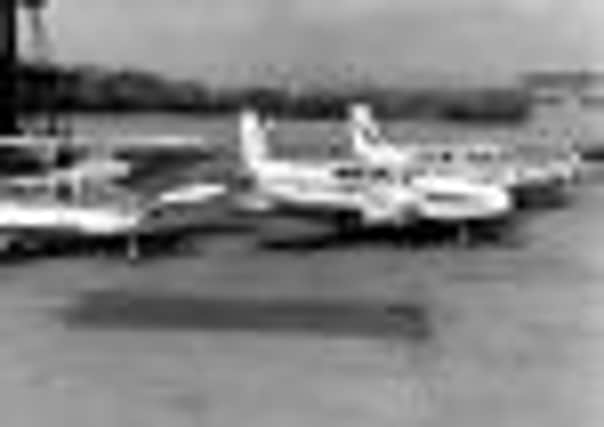Many happy return flights: 50th birthday for Scotland’s Airline


And yesterday Loganair, which markets itself as as “Scotland’s Airline” clocked up another record after 50 years of uninterrupted service.
The carrier, which began with a single route between Edinburgh and Dundee in February 1962, is now the longest running UK airline still trading under its original name.
Advertisement
Hide AdAdvertisement
Hide AdChairman Scott Grier, who led a management buy-out in 1997 said: “No other airline has operated for nearly as long under its original name. During the lifetime of Loganair, as least 50 Scottish-based airlines and aviation companies have come and gone, but we’re still here and thriving.”
Yesterday Mr Grier joined Glasgow Airport managing director Amanda McMillan to cut a specially commissioned cake in celebration of Loganair’s half century.
All passengers travelling by Loganair were offered a glass of champagne along with a cupcake decorated with the company logo.
Loganair, which is based in Dundee, operates services to Orkney, Shetland and the Western Isles and has hubs in Edinburgh, Glasgow, Dundee and Aberdeen. It has operated under the Flybe franchise since 2008.
Its flight between Papa Westray and Westray in the Orkneys covers 2.8km and can take as little as 90 seconds – making it the shortest scheduled flight in the world.
In Barra, Loganair’s Twin Otter planes land on the beach – making it the only place in the world where scheduled flights have to be timed in accordance with the tides and where cockle pickers have to clear the runway before landings.
A copy of the summer timetable from 1971, reproduced to mark the airline’s 50th birthday, shows Orkney inter-island flights could be bought for £1, while flying between Stornoway and Glasgow cost passengers £9.80. Today a flight from Stornoway to Glasgow costs £172.14, flights from Westray to Papa Westray cost £39 return, with all passengers offered a drink of Highland Park whisky.
Mr Grier said adaptability had been the key to the company’s success.
Advertisement
Hide AdAdvertisement
Hide Ad“There have always been airline failures and this will continue, but we’re in good shape to face the endemic uncertainties and vagaries of the airline industry for the next 50 years.”
Mr Grier said expanding in several areas had helped offset a decline in its core passenger traffic. This has included new routes to and within England and Ireland, charters for North Sea oil and gas workers, and mail and freight contracts.
“Following the buy-out in 1997, the company had just five eight-seat Britten-Norman Islander and a single Twin Otter aircraft. Today, Loganair operates a fleet of 20 aircraft delivering vital services throughout Scotland and beyond.”
The chairman said the airline also had the advantage of using small, 34-seat aircraft, which could operate on routes that would be not be viable for larger planes.
He said: “We have a strong balance sheet and are well placed to take advantage when other airlines slip up.”
Loganair has reduced the frequency of flights on several routes, including Aberdeen-Shetland and Glasgow-Orkney, but does not expect to have to make any further such cuts.
Transport minister Keith Brown said: “Over the years Loganair has provided vital lifeline air links essential for maintaining the viability of Scotland’s remotest communities. Its longevity is such a competitive and fast-changing industry is testimony to the acumen and commitment of its management and its workforce and I congratulate them for their success.”